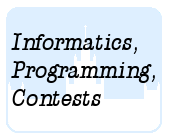Подразделы
Другие разделы
| 1411. Absent |
| 1412. Boy Scouts |
| 1413. Perfect Slice |
| 1414. Diceline |
| 1416. Fibary |
| 1417. Overload |
| 1418. Restaurant tab |
| 1419. Amazed |
Дата и время
06/01/2026 17:20:11
 1415. Elevator
1415. Elevator
 Elevator
Elevator
 Моделирование
МоделированиеОлимпиадные задачи на английском языке

| 24/06/2010 | Лето 2010 дорешивание ( 4E) |
| 30/06/2010 | Лето 2010 - 4 (E) |
Ограничения: время – 1s/2s, память – 64MiB Ввод: input.txt или стандартный ввод Вывод: output.txt или стандартный вывод 
Послать решение Blockly Посылки Темы Где Обсудить (0)
We've all ridden on an elevator and observed its behavior. In this problem, we compute the
behavior of an elevator given its initial state and its departing and arriving passengers. Assume
floors are numbered 1, 2, 3, …, `n` from lowest to highest (despite the anomaly that is building 8),
and a single car travels up and down stopping at floors to drop off departing passengers who have
reached their destination and pick up arriving passengers waiting to go to a destination in its current
direction. The car executes a sweep strategy – traveling as far in its current direction as needed to
visit floors ahead where departures or arrivals occur, then reversing direction and sweeping in the
opposite direction. The car need not go all the way to the top or bottom floor if there are no further
departures or arrivals ahead.
Input Format
The first line of input contains a positive integer `n`, which is the number of floors in the
building. The second line of input gives the initial state of the car – the floor where it is stopped
and the direction (`-1`=down or 1=up) it will move next. The third line of input contains zero or
more floor numbers – the set of floors (excluding the initial floor) where departing passengers wish
to disembark; they are the floors initially selected on the floor request panel inside the car. The
remaining lines of input describe passengers who are waiting on some floor for the car; each such
line contains the floor number where the passenger(s) will embark, followed by a nonempty set of
floors (excluding the embarkation floor) to which they are destined.
Output Format
Given the initial state of the car, output the start state and the sequence of stops at which
passenger departures and arrivals occur when the car executes the sweep strategy. At each stop
the car makes (including the initial state), list departures before arrivals at the stopped floor; if
there are multiple departures or arrivals going to the same floor, they should only be listed once.
Note that departing passengers are willing to disembark no matter what direction the car is going,
but arriving passengers are only willing to embark if the car will next move in the direction of
their destination. Also note that when the direction reverses at a floor, it occurs after departing
passengers disembark and before arriving passengers embark. Format the output as shown in the
output sample below.
Sample Input
10 4 1 3 5 9 1 10 5 2 9
Sample Output
start @ 4 up departure(s) @ 5 up arrival(s) @ 5 up going to 9 departure(s) @ 9 up arrival(s) @ 5 down going to 2 departure(s) @ 3 down departure(s) @ 2 down arrival(s) @ 1 up going to 10 departure(s) @ 10 up

 Начало
Начало